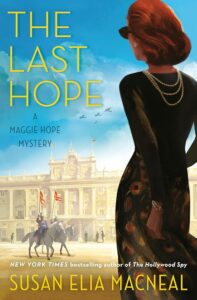Maggie Hope #11
 I’ve been a full on fan of this series from the publication of Mr. Churchill’s Secretary (2012). MacNeal’s combination of adventure story, history and a vivid and intrepid heroine in the form of Maggie Hope has been irresistible. Maggie, an American who came to Britain during the war and snagged a job in Churchill’s office, finds herself coming full circle: in the first novel she found an assassin, in this last novel, she’s asked to be an assassin.
I’ve been a full on fan of this series from the publication of Mr. Churchill’s Secretary (2012). MacNeal’s combination of adventure story, history and a vivid and intrepid heroine in the form of Maggie Hope has been irresistible. Maggie, an American who came to Britain during the war and snagged a job in Churchill’s office, finds herself coming full circle: in the first novel she found an assassin, in this last novel, she’s asked to be an assassin.
Many things have happened to Maggie over the course of this long war, and she’s now a full on member of the SOE – Special Operations Executive – Churchill’s squad of espionage agents, of whom more than 3,000 were women. Their work involved going into occupied Europe and working undercover. The SOE was formed in 1940, and it was dissolved in ’46, so as this series draws to a close, so does the war and the SOE itself. It’s a fitting arc for this wonderful character.
In her last outing, Maggie is to be sent to Madrid to meet up with Coco Chanel. Chanel was a Nazi sympathizer and collaborator and as the war appeared headed for an ending, she knew which side her bread would be buttered. She’s advocating for a “separate peace,” wherein the Allies would reach an agreement with Germany but fight on with the Soviet Union. Obviously communism was seen as a huge threat. Chanel’s idea was for Maggie to carry a letter from her to Churchill, pushing forward this concept – he’s an acquaintance she feels she can prevail upon.
Maggie is not only being asked to meet with Chanel, however, she’s also being asked to assassinate Heisenberg, who the Allies felt might be close to creating a fission bomb. Maggie agrees but insists on meeting and talking with him first to see exactly how close he is to a bomb. Unlike Einstein and many other brilliant scientists, Heisenberg chose to stay in Germany and continued to work with the Nazi government.
This is a full on Maggie story, however, Chanel and Heisenberg functioning as supporting players. As Maggie leaves London she must leave behind her boyfriend and possible fiancée, and she’s just not feeling like herself. She’s a little heavier and she’s very hungry. Any woman could spot what’s happening, and Chanel certainly does when they at last meet up, chiding Maggie on the poor fit of her clothes. Chanel may have been a questionable person in terms of morality, but she was a sensational and gifted designer.
Wartime Madrid is also a character. Maggie’s “handler” warns her that it’s a city full of spies, that no-one can be trusted, and in fact people around Maggie start falling like flies. This beautiful city, under Franco, sees a mix of all nationalities, all uneasily coexisting in a fragile space. Maggie is able to get in practically anywhere when a very famous bullfighter takes an interest in her, and MacNeal gives the reader a bird’s eye view of a bullfight and the culture that surrounds it.
There is much underlying tension in this story and Maggie’s life is certainly in danger as she weighs a decision on what to do about Heisenberg. MacNeal skillfully pulls in the details of the War and of Europe at a very specific time and manages to keep this book feeling, not like a dry historical tome, but a vivid story of a brave girl trying to do the right thing. That essentially is the thread of the series. Maggie is plunged into events beyond her control, and manages to do what’s right. She’s a wonderful character.
MacNeal also nicely wraps up the series, providing closure of some the details of Maggie’s personal life. As the war heads to an ending, the reader is certainly wondering what’s next, but if you’re at all like me, you’re hoping it’s all good for Miss Maggie Hope. Thanks for the reading memories, Ms. MacNeal. — Robin Agnew